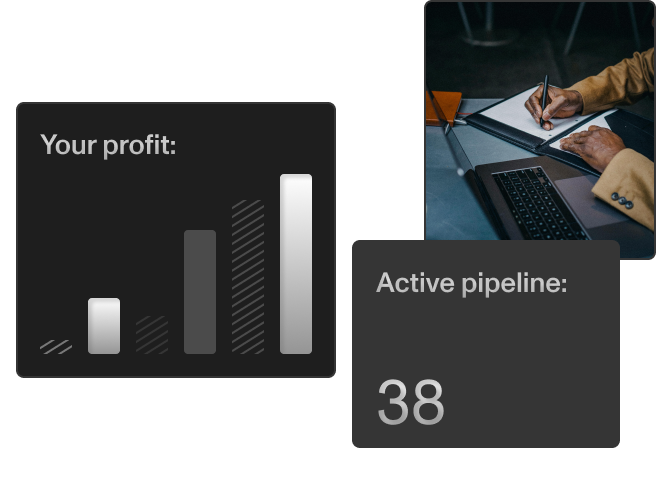The mortgage market reacts to constantly shifting economic forces, allowing brokers to predict customer volume. Inflation rising? Expect a drop in borrowers. Low unemployment rates? Demand for mortgages could soar.
But what does this mean for the mortgage industry overall? How do economic trends affect homebuying behavior and mortgage rates? Recognizing the relationship between these factors could help brokers and loan officers plan for the future.
In this article, we’ll look at common economic trends and explain how they might impact your business.
Understanding Economic Indicators
Mortgage rates are technically determined on a lender-by-lender basis. However, they’re affected by several key economic indicators:
Inflation
Inflation refers to an increase in prices over time. When it’s high, mortgage rates tend to increase as lenders try to offset the decrease in purchasing power. Homebuyers may lean toward fixed-rate mortgages if they believe the inflationary period will continue.
Mortgage rates are more likely to remain stable or decrease when inflation is low.
Interest Rates
According to US Bank, “the housing market represents a segment of the economy directly impacted by rising interest rates.” Between 2022 and 2024, the Federal Reserve (the Fed) raised interest rates by more than 5%, causing a corresponding spike in home mortgage rates. Unsurprisingly, this activity affected home sales. Higher mortgage rates increase borrowers’ expenses and make it harder for them to get approved.
GDP Fluctuations
GDP, or gross domestic product, is the total value of a country’s domestic production. Rapid GDP growth often signals high mortgage demand and, as a result, higher mortgage rates. When GDP declines, it could be a sign of a slow economy.
Factors Influencing Mortgage Rates
Government spending and tax policies are key factors influencing mortgage rates. When the government increases spending or cuts taxes, it can stimulate economic growth and potentially raise inflation, which may lead to higher mortgage rates.
In contrast, austerity measures, such as budget cuts or tax increases, tend to slow economic growth and reduce inflationary pressure, often resulting in lower mortgage rates.
The Federal Reserve, America’s central bank, significantly affects mortgage rates. The bank manages the country’s monetary policy, which involves controlling interest rates and implementing quantitative easing.
As mentioned above, the Fed raised rates significantly after the 2020 to 2021 pandemic. Its goal was to stem the spiraling inflation that arose at the time, resulting in higher mortgage rates and fewer home sales. Throughout 2023, mortgage applications plunged to their lowest levels in almost 30 years.
Economic Trends and Homebuying Behavior
Borrowers are sensitive to market changes and mortgage lending trends. Millions of Americans want to buy a home, but the economy often hinders their efforts.
When economic conditions are unfavorable, homebuying behavior slows down. This trend means fewer people buying homes and fewer mortgages. For example, 2024’s high home prices, mortgage rates, and economic pessimism have hampered the housing market. A May 2024 poll by Bank of America shows that nearly 60% of potential homebuyers are unsure if they should buy a home in this climate.
As a broker or loan officer, economic uncertainty may interfere with your pipeline as there’s increased competition for the borrowers who remain in the market.
However, if the economy’s booming, finding customers is much easier. More people are willing and able to become homeowners in that environment. It’s also easier if mortgage rates are low. In 2021, mortgage rates fell to historic lows, causing that year’s mortgage originations to rocket to $4.51 trillion in volume.
The number dropped precipitously in 2022 when the Fed began its interest rate hikes. Mortgage rates quickly rose, too, and homebuying activity immediately slowed down. Mortgage originations in 2022 totaled $2.75 trillion. In 2023, the volume fell to $1.64 trillion. Reports show that the market is recovering slightly in 2024, although mortgage rates in 2024 are still elevated.
The stark difference in origination volume between 2021 and 2022 shows how much economic ups and downs affect buyers and loan officers.
Strategies for Mortgage Professionals
As a mortgage professional, you must prepare for borrowers to ebb and flow. Your business can only survive if you develop strategies that work in different climates.
For example, when the economy stalls and connecting with leads is hard, you may want to concentrate on different mortgage products. Some examples include government-backed loans with easier credit requirements and adjustable-rate mortgages that start with lower rates making it easier to qualify and easier for borrowers to stomach rates.
Another strategy is to target niche borrower segments, such as existing homeowners who have equity in their homes that they can tap into.
If the economy is strong and your team has viable leads, you can promote specialized services like jumbo loan offerings. These riskier loans exceed the limits set by government-backed products and are often sought by high-net-worth borrowers.
No matter the market conditions, focus on customer service and building relationships within the industry. Referrals can be extremely valuable because you don’t have to pay to market to the new customer directly.
You can’t predict mortgage industry trends, but you can stay up-to-date on the economy. Continuous planning and education are essential within the mortgage industry.
Mortgage professionals need a thorough understanding of economic trends to stay competitive in the modern housing market. A strong economy, low mortgage rates, and consumer confidence all positively impact your pipeline by producing more viable leads. When the opposite occurs, you must be prepared with alternative strategies like targeting niche segments and promoting specialized services.
Educating yourself on market changes will help you prepare for various economic realities. Follow Sonar’s blog to stay up-to-date on news affecting the mortgage lending industry.








